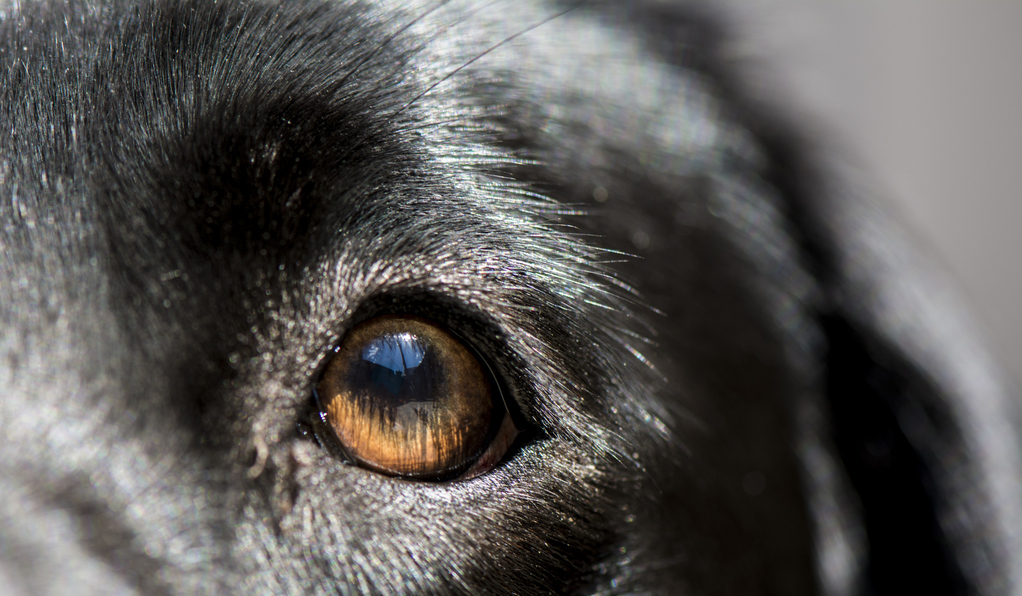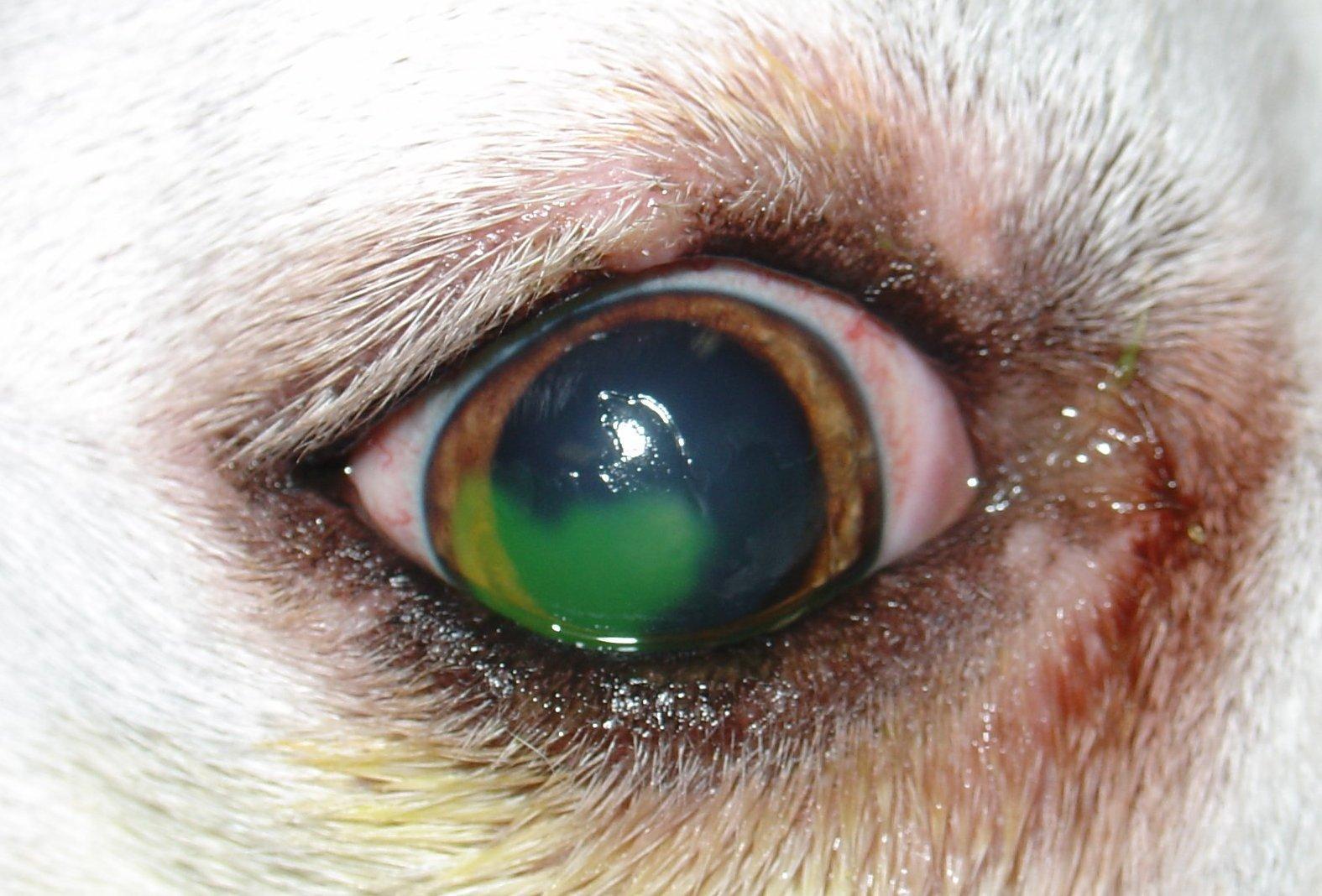Ulcer in eye dog
The eye ulcer in dogs is an affection of the cornea, sometimes serious, which can lead to total or partial blindness.
Since the symptoms of corneal damage in dogs are very varied, it is important to know how to recognize them in order to provide your pet with quick health care and avoid losing his sight in case of a problem. Today, I would like to take a closer look at eye ulcers in dogs, their causes and consequences, and the best way to deal with them.
What is an eye ulcer in dogs?
An eye ulcer, also known as a corneal ulcer, is a wound that affects the cornea of a dog. More precisely, an ulcer is a lesion that does not heal well, because it is associated with a loss of tissue substance that disintegrates and cannot regenerate. It is this feature that gives ulcers their typical "crater" shape, with the edges of the skin collapsing as the tissue deteriorates, and makes them prone to infection.
An ulcer can have different degrees of severity, depending on the extent of tissue damage. All areas of the skin and mucous membranes can ulcerate, but in the case of an eye ulcer, the cornea is affected.
The cornea is the translucent front surface of the eye through which light passes, allowing the retina to capture images. It is made up of several layers of cells: the epithelium (on the surface), the stroma (in the middle) and the endothelium (at the bottom).
In dogs, unlike humans, the cornea is the only visible part of the eye, while the sclera (white of the eye) is almost entirely hidden by the animal's eyelids. Therefore, the cornea is the first line of defense in case of shocks, infections, light aggression and trauma by foreign bodies (dust, sand grains, etc.).
The different types of eye ulcers in dogs
The different types of dog eye ulcers are categorized according to their location (deep, superficial or medium) as well as their severity and evolution.
As a general rule, when the ulcer only affects one third or less of the cornea, it is called a superficial ulcer. When it extends over more than one third, it is called a medium ulcer, and when it affects more than two thirds of the cornea, it is called deep. In most cases, an eye ulcer is superficial at first, then it becomes medium and deep if left untreated.
Benign eye ulcer in dogs
The benign eye ulcer is still in its early stages of development. It corresponds to a recent, superficial and non-infected wound. Despite its benign appearance, this type of ulcer must be treated by a veterinarian as soon as possible. It is not only very painful for the dog, but also has every chance of evolving into a medium and then deep ulcer, potentially with collagenases.
Collagenase eye ulcer in dogs
A collagenase ulcer is a severe form of ulcer complicated by infection, which results in very rapid destruction of the stroma tissue, the thickest layer of the cornea that acts as a barrier. Collagenases are substances produced by bacteria or cells in distress. They cause lysis, i.e. the dissolution of the collagen constituting the cell membrane. This defense mechanism makes it possible to destroy pathogens, but at the same time causes significant damage to healthy tissue and prevents healing. This is how an ulcer "digs" itself indefinitely in the absence of treatment, until it potentially causes a perforation of the cornea.
Indolent eye ulcer in dogs
Indolent eye ulcer is a lesion that does not heal due to an abnormality in the cornea that prevents new scar cells from adhering to the stromal tissue. It can occur as a complication of a classic ulcer, or it can occur spontaneously in dogs with this corneal defect. Some breeds are predisposed to it, especially the Boxer. In fact, the indolent ulcer is also called the Boxer ulcer, the atonic ulcer or the refractory ulcer. Age is a determining factor, and dogs older than 6 years are overrepresented.

Symptoms of eye ulcers in dogs
First of all, it should be noted that eye ulcers are a pernicious lesion in dogs, which can be difficult to detect in its early stages for the simple reason that it affects totally translucent tissue, the cornea. Simply put, the dog's cornea is as transparent as glass, and almost invisible. The wounds on the cornea are also transparent, including ulcers.
Corneal tissues may turn white, opaque or blue in the event of irritation or a wound, but this usually occurs late, when the ulcer is already significant. Note that "late" here refers to the evolution of the ulcer, and not to a time frame: an ulcer can significantly worsen and stain the cornea in a few days, or even hours, only.
There are, however, some signs that may alert you to the problem. A dog with an eye ulcer is often visibly embarrassed, tends to complain and shows signs of pain. The appearance of the eye is often revealing, especially in the case of an indolent ulcer. The cornea may become opaque and take on a white or bluish tint, although this is not systematic.
The animal is usually sensitive to light, which is reflected in miosis, i.e. a decrease in the diameter of the pupil of the affected eye, which is no longer the same size as that of the healthy eye. He may keep the eye completely or partially closed, and his third eyelid is sometimes visible. The dog may also try to relieve the pain and itching by scratching the eye.
Thicker or thinner tears may appear, with different colors (brown, yellow, green, white or translucent). The sclera of the eye is sometimes red and visibly irritated, as well as the surrounding tissues (inner eyelids, conjunctiva, etc.).
Causes of eye ulcers in dogs
There are a number of conditions and diseases that can lead to eye ulcers in dogs. However, in most cases, it is a trauma that causes the problem. A scratch, a branch, a toy in the eye, a grain of sand or dust lodged on the cornea which, when rubbed, causes a wound, are all common causes of corneal ulcers in our dogs.
A splash of a corrosive product, such as bleach, can also cause an eye ulcer, especially since this type of substance destroys the cells over and over again until it has been completely removed by rinsing with water for 45 minutes. However, trauma is not the only possible cause of eye ulcers in dogs, far from it.
Bacteria and viruses can also cause these symptoms, as well as congenital malformations of the cornea that can lead to spontaneous ulcers - such as the indolent Boxer ulcer, discussed earlier in this article.
Dysplasias of the surrounding tissues, such as the famous entropion or ectopic lash, may also be involved. An ectopic eyelash is an eyelash that does not grow in the right direction, or not in the right place, and then rubs the cornea of the dog, until it deteriorates.

Treatment and prognosis of an eye ulcer in dogs
An ulcer, by definition, is a wound that can be very delicate to heal and has a high tendency to deepen and spread rapidly. Without the intervention of a veterinarian, the risk of complication, and in particular of bacterial infections and ocular perforation, is major, and the animal risks - at best - total or partial blindness, in addition to suffering martyrdom.
If you suspect that your dog has injured his eye, it is essential to take him to a veterinarian so that he can be taken care of quickly, before the lesion gets out of hand. Don't hesitate to consult even if his cornea seems to be in perfect condition: the tissues involved are transparent, so an eye ulcer is usually perfectly invisible in its early stages.
The veterinarian will perform a fluorescein test by applying a colored solution to the dog's eye to get a good view of the lesion. Fluorescein allows to stain only the cells of the stroma, the middle layer of the cornea, which occurs only when the epithelium, the thin and upper layer of the cornea, is damaged.
Depending on the appearance of the lesion and the health of the dog, further examination of the eye, including taking samples, may be necessary to look for bacteria, viruses, or cellular abnormalities that may indicate a malignant lesion. In the case of a benign ulcer, treatment usually consists of antibiotic and healing eye drops or ointments.
If the dog is in too much pain, painkillers may be used to supplement the treatment, and a collar may be necessary to prevent the dog from aggravating the wound by scratching the eye. A benign ulcer should normally heal in 4 to 5 days, otherwise it should be considered an atonic, or indolent, ulcer. The prognosis of a well-cared-for dog is excellent.
In the case of indolent ulcers, it is often necessary to remove the cells of the epithelium, the superficial layer of the cornea, which impede healing. Abrasive treatments, laser or medicated, are then necessary. The evolution of the healing process must be closely monitored: the size of the ulcer, deliberately enlarged during the treatment, must be reduced by half in 1 week, and the healing must be complete in 2 weeks.
In case of failure of this type of treatment, a surgical intervention can be considered in order to scarify the cornea to make it adherent. The wearing of a dressing lens is sometimes indicated, as well as the artificial closure of the eyelid which is then temporarily sutured. If the treatments are sometimes long (several weeks or months) and multiple, requiring very regular control consultations, the prognosis of an indolent ulcer of the dog is rather good, provided that the master takes the trouble to have his companion treated correctly.
Collagenase ulcers are more difficult to treat, especially when they involve a significant loss of substance. Emergency veterinary management is highly recommended. When there is limited loss of tissue, treatment similar to that preferred for benign ulcers may be sufficient, although increased follow-up is required and healing takes longer.
When the loss of substance is significant, the first-line treatment is surgical and consists of grafting healthy corneal tissue. The prognosis is then more reserved, as the risks of bacterial complications and ocular perforation are high.
Regardless of the type of eye ulcer your dog has, the cause of the problem (foreign body, ectopic lash, bacterial infection, etc.) should also be investigated and, when possible, managed to prevent recurrence.
FAQ
How do I know if my dog has an eye ulcer?
The eye ulcer is often invisible when it is benign, so we observe signs of pain rather than the wound itself: the dog may complain, scratch the eye, keep the eyelid totally or partially closed. In case of a deep (collagenase) or indolent ulcer, a whitening or blueness of the cornea can sometimes be observed. An ulcer is often accompanied by tearing, colored or not, thick or liquid, and visible redness of the surrounding tissues (sclera, conjunctiva, inner surface of the eyelids, etc.).
What is an eye ulcer in dogs?
An ulcer is a particular wound, the specificity of which is to heal badly or not to heal at all. The lesion is typically crater-shaped - although it is often not visible when it touches the cornea - and deepens rapidly.
How do you treat an eye ulcer in dogs?
The treatment of an eye ulcer depends on its severity, but veterinary care is always necessary, regardless of the extent of the problem. A small, benign ulcer can quickly degenerate if left untreated because of its tendency to not heal and to grow rapidly. Local medical treatments (eye ointments, drops, etc.) are usually sufficient in superficial cases. The most severe eye ulcers often require surgery, and may take several weeks or months to heal.
Can a dog recover from an indolent eye ulcer?
Yes, the prognosis of a dog suffering from an indolent or atonic eye ulcer is good, but only if the owner is involved in the healing of his pet. This can take weeks or even months and require several successive treatments and regular check-ups.
An eye ulcer in a dog is not always a serious condition, but it can quickly become one because of the nature of this lesion, which typically heals poorly - or not at all - and is particularly prone to infection. The location of the corneal ulcer also makes it a delicate lesion, whose consequences on the animal's health can quickly be dramatic. The risk of blindness, partial or total, is relatively high, especially in case of a deep ulcer.
There are no preventive treatments to protect your dog from an eye ulcer: everything depends on the reactivity of the owner, who should not hesitate to take his faithful companion to a veterinarian as soon as he observes any discomfort, pain or eye redness, even slight.

